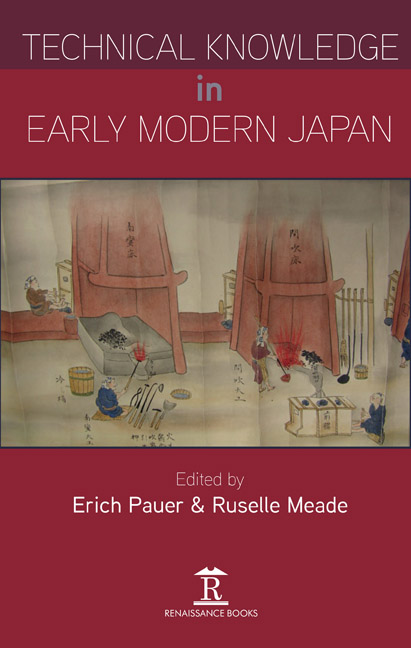Book contents
- Frontmatter
- Contents
- Acknowledgements
- Introduction: Remarks on the History of Technology in Japan
- 1 Production Techniques in Early Modern Japan as seen through ‘Famous Products of Japan from Mountain and Sea, Illustrated’ (Nippon sankai meisan zue, 1799)
- 2 Vehicles of Knowledge: Japanese Technical Drawings in the Pre-modern Era, 1600–1868
- 3 Dissemination of Knowledge and Technology: The Extensive Range of Exhibitions in Japan in the Eighteenth and Nineteenth Centuries
- 4 Knowledge on Mining and Smelting and Its Dissemination in the Edo Period
- 5 Tanaka Hisashige and His Myriad Year Clock: Its Technological Characteristics and Historical Background
- 6 A Statistical Analysis of Tōkyō Meikō Kagami (with a Focus on Highly Skilled Metalwork Craftsmen)
- 7 Boiler Manufacture in Late-nineteenth Century Japan: From First Beginnings to Nationwide Expansion
- Appendix: Selected Sources on the Japanese History of Technology (especially on series)
- List of Contributors
- Index
2 - Vehicles of Knowledge: Japanese Technical Drawings in the Pre-modern Era, 1600–1868
Published online by Cambridge University Press: 30 April 2022
- Frontmatter
- Contents
- Acknowledgements
- Introduction: Remarks on the History of Technology in Japan
- 1 Production Techniques in Early Modern Japan as seen through ‘Famous Products of Japan from Mountain and Sea, Illustrated’ (Nippon sankai meisan zue, 1799)
- 2 Vehicles of Knowledge: Japanese Technical Drawings in the Pre-modern Era, 1600–1868
- 3 Dissemination of Knowledge and Technology: The Extensive Range of Exhibitions in Japan in the Eighteenth and Nineteenth Centuries
- 4 Knowledge on Mining and Smelting and Its Dissemination in the Edo Period
- 5 Tanaka Hisashige and His Myriad Year Clock: Its Technological Characteristics and Historical Background
- 6 A Statistical Analysis of Tōkyō Meikō Kagami (with a Focus on Highly Skilled Metalwork Craftsmen)
- 7 Boiler Manufacture in Late-nineteenth Century Japan: From First Beginnings to Nationwide Expansion
- Appendix: Selected Sources on the Japanese History of Technology (especially on series)
- List of Contributors
- Index
Summary
INTRODUCTION
PEOPLE TRANSFER KNOWLEDGE in various ways. The simplest form of transmission is to speak or to hear, but such knowledge is not sustainable and is easily lost. One way to make knowledge sustainable is to write it down. Once in a written form – this can be a text, but also pictures and drawings – it then can be forwarded. Therefore, for us, books, technical drawings, and the like seem to be the most suitable ‘vehicles’ of knowledge. However, not every drawing is a vehicle of knowledge, particularly when it comes to technical knowledge. One must examine the intrinsic link between image, technology, and the rules set for codification of practical knowledge in printed form. Different kinds of such prescriptive literature and so-called ‘how-to books’, to use a contemporary term, such as books of secrets and recipes, show how practices became formalized and codified.
SIMPLE DESCRIPTIONS OR TECHNICAL MANUALS?
Although writing had already arrived from China by the fourth century CE, the Japanese book tradition dates back only to the eighth century. These Japanese writings are usually not books with technical content, as they contain myths, representations of history, and geographical writings. However, some refer to buildings, roads, watchtowers, canals, dams, ponds and trenches, and especially temples and shrines. These provide evidence of a differentiated class of craftsmen with a marked hierarchy. It can be assumed that this hierarchy was based on skill. Unfortunately, these books give us no details about how these different craftsmen were trained, and contemporary technical textbooks or manuals for these trades do not exist.
Aside from references to craftsmen in ancient writings, pictorial representations of craftsmen at work, or technical details relating to the construction of buildings (mostly temples or shrines), are rare. However, a strange object stands out in ancient writings: it is the first evidence of a ‘technical drawing’, or the passing on of technical knowledge in written form.
The illustration shows the base of the Shintō shrine at Izumo, one of the oldest religious sites in Japan, near the Sea of Japan. What we see is a cross-sectional view showing the shrine's pillars, each formed of three tree trunks. The drawing, which is obviously ‘technical’, dates back to the eighth century and is thus the oldest drawing of its kind in Japan.
- Type
- Chapter
- Information
- Technical Knowledge in Early Modern Japan , pp. 28 - 54Publisher: Amsterdam University PressPrint publication year: 2020



